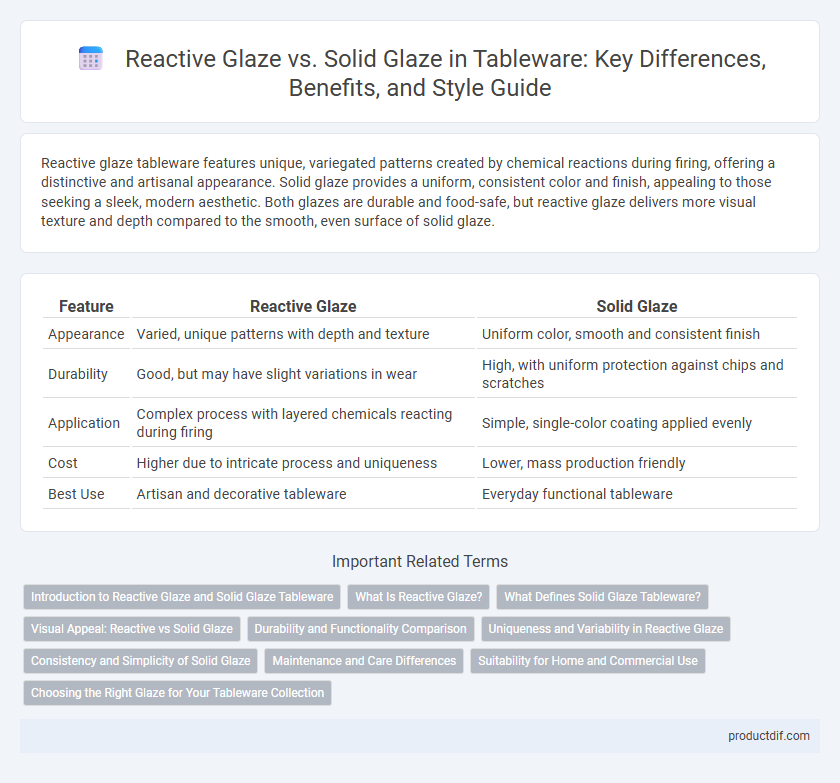Reactive glaze tableware features unique, variegated patterns created by chemical reactions during firing, offering a distinctive and artisanal appearance. Solid glaze provides a uniform, consistent color and finish, appealing to those seeking a sleek, modern aesthetic. Both glazes are durable and food-safe, but reactive glaze delivers more visual texture and depth compared to the smooth, even surface of solid glaze.
Table of Comparison
| Feature | Reactive Glaze | Solid Glaze |
|---|---|---|
| Appearance | Varied, unique patterns with depth and texture | Uniform color, smooth and consistent finish |
| Durability | Good, but may have slight variations in wear | High, with uniform protection against chips and scratches |
| Application | Complex process with layered chemicals reacting during firing | Simple, single-color coating applied evenly |
| Cost | Higher due to intricate process and uniqueness | Lower, mass production friendly |
| Best Use | Artisan and decorative tableware | Everyday functional tableware |
Introduction to Reactive Glaze and Solid Glaze Tableware
Reactive glaze tableware features a unique, variegated surface created by chemical reactions during firing, producing unpredictable patterns and color variations. Solid glaze tableware offers a uniform, consistent finish with a single, even color that enhances a clean, modern aesthetic. Both options provide durable, food-safe coatings ideal for everyday use or special occasions.
What Is Reactive Glaze?
Reactive glaze is a ceramic finish characterized by its unique, variegated patterns created during kiln firing, where chemical reactions cause unpredictable variations in color and texture. Unlike solid glaze, which offers uniform, smooth surfaces, reactive glaze produces a dynamic, organic aesthetic favored for artisanal and handmade tableware. This glaze type enhances the tactile experience and visual appeal of plates, bowls, and mugs through its richly layered, mottled effects.
What Defines Solid Glaze Tableware?
Solid glaze tableware is defined by its uniform, opaque surface coating that provides consistent color and a smooth finish. This type of glaze is non-reactive, ensuring durability and resistance to stains, scratches, and chipping, making it ideal for everyday use. Unlike reactive glaze, solid glaze does not display variations in color or texture, resulting in a clean, modern aesthetic that complements any table setting.
Visual Appeal: Reactive vs Solid Glaze
Reactive glaze creates unique, variegated patterns with subtle color variations and textures that enhance the visual appeal of each piece, making every item visually distinct. Solid glaze offers a uniform, smooth finish with consistent coloration, providing a clean and modern look perfect for minimalist table settings. Choosing between reactive and solid glaze depends on whether a dynamic, artisanal aesthetic or a sleek, uniform appearance is desired for the tableware.
Durability and Functionality Comparison
Reactive glaze offers a unique, variegated finish that enhances scratch resistance due to its varied texture, making it ideal for everyday use in tableware. Solid glaze provides a uniform, smooth surface that excels in stain resistance and ease of cleaning, contributing to long-lasting functionality. Both glazes maintain durability, but reactive glaze is preferred for artistic appeal while solid glaze is favored for consistent performance in kitchens and dining settings.
Uniqueness and Variability in Reactive Glaze
Reactive glaze offers a unique and variable finish on tableware due to its chemical reactions during firing, creating unpredictable patterns and color variations that make each piece one-of-a-kind. In contrast, solid glaze provides a consistent, uniform appearance across all items, emphasizing uniformity over individuality. The organic, dynamic textures of reactive glaze enhance the aesthetic appeal and artistic value of handcrafted ceramics.
Consistency and Simplicity of Solid Glaze
Solid glaze offers superior consistency and simplicity compared to reactive glaze, ensuring uniform color and texture across all tableware pieces. This predictable finish reduces manufacturing variability, making solid glaze ideal for large-scale production and matching sets. Unlike reactive glaze, which creates unique, unpredictable patterns, solid glaze provides a clean, minimalist aesthetic favored in contemporary tableware design.
Maintenance and Care Differences
Reactive glaze tableware requires gentle hand washing and avoidance of abrasive scrubbers to preserve its unique color variations and textured finish, while solid glaze pieces offer greater durability and usually withstand dishwasher cleaning without fading. Reactive glaze's porous surface may absorb stains or odors if not properly sealed, necessitating prompt cleaning and occasional resealing, unlike the non-porous, smooth surface of solid glaze that resists staining and is easier to maintain. Proper care for reactive glaze extends its aesthetic appeal, while solid glaze provides practical convenience for everyday use.
Suitability for Home and Commercial Use
Reactive glaze offers unique variations and depth in tableware surfaces, making it ideal for home use where aesthetic appeal and individuality are valued. Solid glaze provides a consistent, durable finish that withstands heavy use and frequent cleaning, making it highly suitable for commercial environments such as restaurants and hotels. The choice between reactive and solid glaze depends on balancing artistic expression with practical durability needs in different settings.
Choosing the Right Glaze for Your Tableware Collection
Reactive glaze offers unique, variegated patterns that create one-of-a-kind tableware pieces, enhancing visual interest and artistic appeal. Solid glaze provides uniform, consistent coloring that is ideal for matching sets and minimalist design preferences. Selecting the right glaze depends on whether you prefer distinct, artisanal aesthetics or classic, cohesive looks for your tableware collection.
Reactive Glaze vs Solid Glaze Infographic

 productdif.com
productdif.com